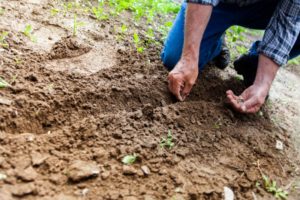
If your new sod isn’t rooting, it may be a sign of poor soil quality due to fungus.
There are little things more frustrating when it comes to lawn care than your brand new sod not rooting properly. This essentially means that the seeds inside the sod are not germinating properly into the ground. While this is really annoying, it usually signifies there is something else afoot underneath the soil, and your yard may be more unhealthy than it may appear from the surface. Here are some common reasons why your new sod might not be rooting properly into your lawn or soil plot.
Bad Spots
In normal circumstances, most sod types, including Kentucky bluegrass sod, will root in around 10 to 14 days’ time. However, you can actually overwater new sod, which can cause lots of problems. Too much water can increase the growth of fungi, which can kill seeds before they have the chance to germinate. In addition, the physical location of the new sod may affect its germination rate. Areas with too much shade may not be appropriate for the grass type to grow in, so in that case, it’s better to move the sod to a more sunny area for the best growth potential.
More About Fungus
As mentioned before, fungal growth can prevent new sod from germinating and rooting into the soil. Fungi thrive in wet and warm conditions and are unfortunately very common in the late spring and summer months when laying new sod. The best action to take if you notice or suspect fungal growth in your turf grass yard is to apply fungicide onto the soil before placing any new sod to clear out any fungus beforehand.
Crabgrass
Along with fungi, crabgrass is the natural enemy of landscaping and lawn care lovers. These extremely annoying weeds are prone to reproducing incredibly fast and soon will take up all the nutrients from the soil that new sod needs to grow and root. Avoiding a crabgrass infestation is best-taken care of in early March, just as the soil begins to thaw. Unfortunately, one bad thing about crabgrass is that the seeds can stay dormant for long periods of time. So an area that previously had a crabgrass infestation may seem fine and crabgrass-free one day, just to become completely infested the next. The best way to take care of that pesky crabgrass for good is to apply herbicides to the soil in early March. The hope is that this will kill any unwanted leftover crabgrass seeds or sprouts remaining in the soil so that the new sod placed later in the year will grow happy and healthy.
Have More Questions? Stay in Touch!
Order early and order often to ensure the best service possible. Contact us through our online page. Please find us at 27616 Little Lane, Salisbury, Maryland 21801. Our phone number is 410-726-6103, and our fax number is 410-742-6550. Speak to Jason Anderson for Turf Grass Sales. Reach him by email at jason@quanticocreeksod.com. Finally, follow us on social media on Facebook, LinkedIn, and our blog!
